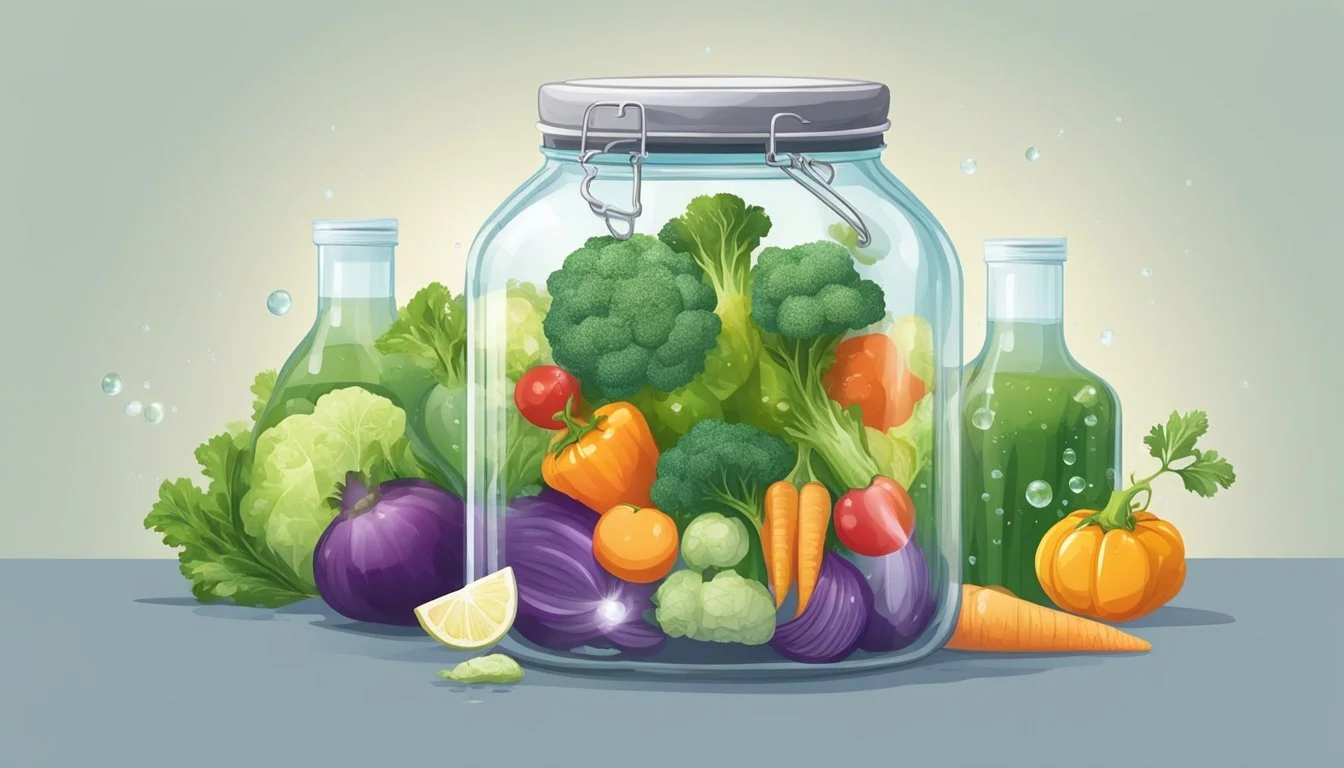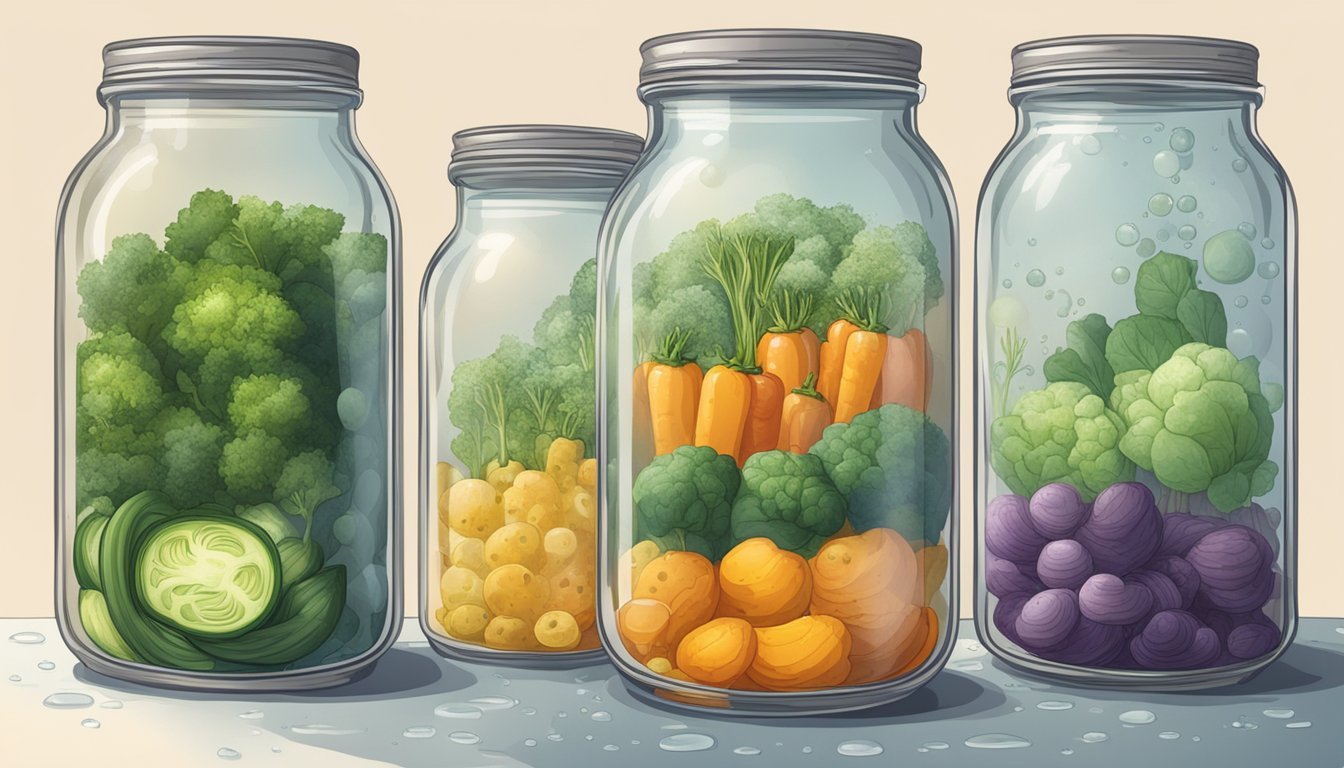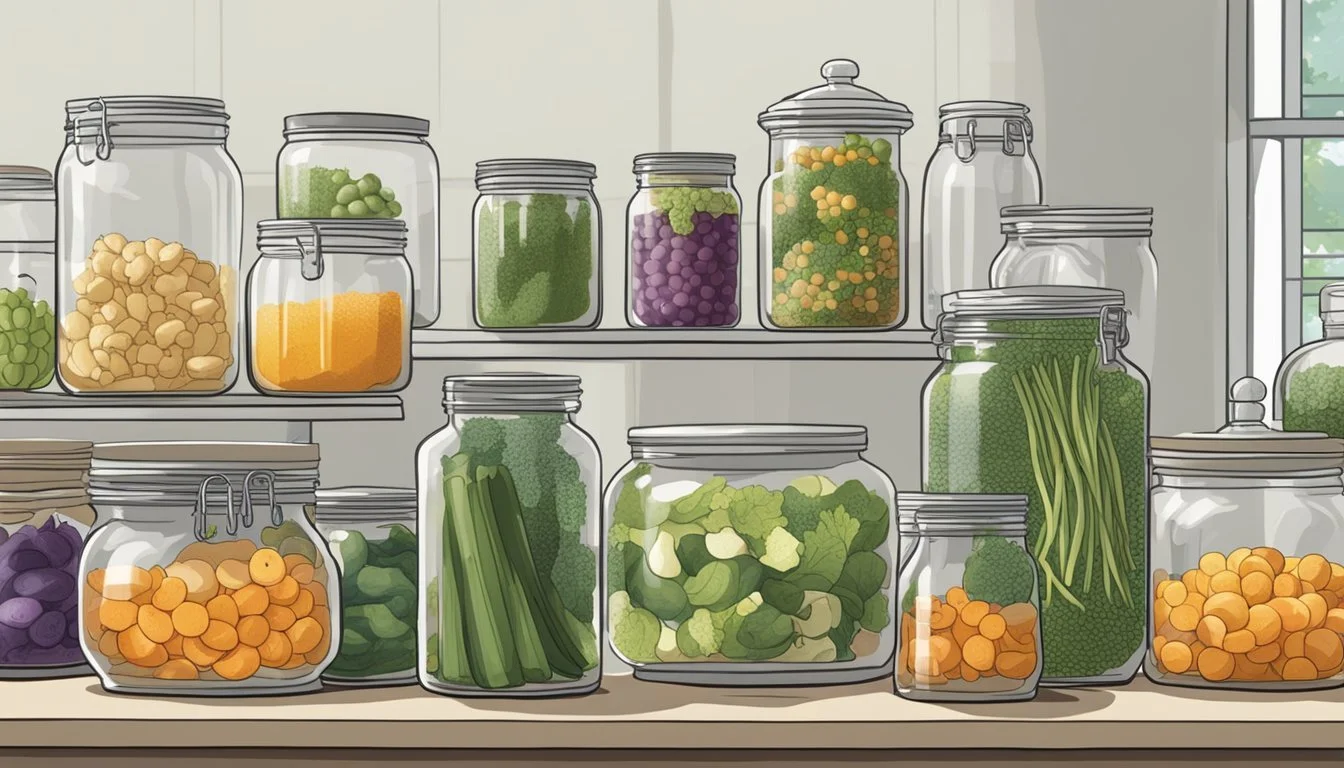How to Ferment Vegetables
Your Guide to Easy Home Fermentation
Fermenting vegetables is a time-honored practice that transcends cultures, turning simple produce into tangy, nutritious delights. This process harnesses the power of lacto-fermentation, which occurs when natural bacteria feed on the sugar and starch in the food, creating lactic acid. It preserves vegetables and amplifies their flavor, while also enhancing their digestibility and increasing vitamin levels.
The essential ingredients for fermentation are fresh vegetables, salt, and water. Vegetables can be prepared in various ways such as chopping, slicing, or leaving them whole, depending on the recipe and desired result. The salt acts as a catalyst in the fermentation process and ensures that unwanted bacteria do not spoil the batch, while water creates a brine that submerges and protects the vegetables from exposure to air.
To begin fermenting, vegetables are typically placed in a jar or other fermentation vessel, often along with spices or herbs to infuse additional flavors. The brine is then prepared and poured over the vegetables to ensure they remain submerged during the fermentation process. A weight is sometimes used to keep the vegetables below the liquid's surface, which is crucial to create an anaerobic environment where fermentation can occur effectively. The vegetables are left to sit at room temperature for a period of time, after which they become tangy and probiotic-rich, ready to be enjoyed or stored for longer periods.
Understanding Fermentation
When it comes to fermenting vegetables, it's essential to comprehend the biological process that transforms raw ingredients into nutrient-rich fermented foods. (What wine goes well with fermented foods?) This section delves into the science behind fermentation and the multitude of benefits it offers.
The Science of Fermentation
Fermentation is a metabolic process in which lactic acid bacteria break down sugars in the absence of oxygen. It typically occurs in an anaerobic (oxygen-free) environment. In the context of vegetable fermentation, salt is used to create this environment by drawing out water from the vegetables and inhibiting the growth of bad bacteria, while promoting the proliferation of good bacteria, such as probiotic bacteria.
The primary bacteria involved in lacto-fermentation are from the genus Lactobacillus. These bacteria convert sugars present in vegetables into lactic acid, which acts as a natural preservative and gives fermented foods their distinctive tangy flavor. The process of fermenting vegetables, therefore, not only preserves them but also enriches them with beneficial enzymes and increases their vitamin content.
Benefits of Fermentation
The health benefits of consuming fermented vegetables are significant. They provide a rich source of probiotics, which are essential for maintaining a healthy gut flora. A balanced gut microbiota is linked to improved digestion, a robust immune system, and may even contribute to better overall health.
Incorporating fermented foods into one's diet has been shown to aid digestion by introducing lactic acid bacteria that help break down food more efficiently. Additionally, the presence of probiotics in fermented vegetables can help bolster the immune system by enhancing the body's defense mechanisms against pathogens. Regularly consuming foods high in probiotics can contribute to a well-balanced microbial environment in the gut, promoting a healthy composition of gut flora.
Choosing Your Vegetables
When starting the fermentation process, the selection of vegetables is a critical step. It's important to understand which vegetables ferment well and the differences between organic and non-organic choices.
Best Vegetables for Fermenting
The best vegetables for fermenting are those that can withstand the fermentation process without losing their texture or flavor. Here is a list of vegetables known for producing excellent results:
Cabbage: A staple for fermentation, known for making sauerkraut.
Carrots: Their natural sweetness intensifies, adding a pleasant flavor.
Cucumbers: Commonly used for pickles; crunchy and refreshing.
Radishes: Add a peppery kick to any fermentation mix.
Beets: Their earthy flavor deepens with fermentation.
Onions: Bring a robust flavor to ferments and pair well with other veggies.
Peppers: Spice up ferments whether sweet or hot varieties.
Green Beans: Stay crunchy and absorb flavors well.
Tomatoes: Less common but can be used for a tangy, salsa-like ferment.
These vegetables not only retain their consistency during fermentation but also contribute a spectrum of flavors ranging from sweet and tangy to spicy and robust.
Organic vs Non-Organic Vegetables
The choice between organic and non-organic vegetables can affect the quality and purity of the ferment. Organic vegetables are grown without synthetic pesticides and fertilizers, which some prefer to avoid in their fermentation process to ensure a natural and uncontaminated result. They may also have a richer microbial life which is beneficial for fermentation. Non-organic vegetables can still be used effectively, but they should be thoroughly washed to remove surface chemicals. Here’s a brief comparison:
Aspect: Pesticide Use
Organic Vegetables: No synthetic pesticides used
Non-Organic Vegetables: May include synthetic pesticides
Aspect: Taste
Organic Vegetables: Some argue a better, more natural taste
Non-Organic Vegetables: Taste can vary
Aspect: Cost
Organic Vegetables: Typically more expensive
Non-Organic Vegetables: More cost-effective
Aspect: Availability
Organic Vegetables: May be limited depending on location and season
Non-Organic Vegetables: Widely available
Aspect: Microbial Life
Organic Vegetables: Often rich in beneficial microbes for fermentation
Non-Organic Vegetables: Varies, sometimes lower due to pesticide residue
Whether one opts for organic or non-organic produce, it's important to choose fresh, unblemished vegetables for the best fermentation results.
Preparation of Vegetables
To ensure the success of vegetable fermentation, one must pay close attention to the initial steps of washing, chopping, and proper seasoning. These foundational activities set the stage for flavor development and preservation.
Washing and Chopping
Before fermenting, vegetables should be thoroughly washed to remove dirt and potential contaminants. After washing, they should be chopped into even pieces, which encourages uniform fermentation. Different vegetables require unique chopping techniques; for instance, slicing cucumbers for pickles differs from shredding cabbage for sauerkraut.
Cucumbers: slice into 1/4 inch rounds
Cabbage: shred finely
Carrots: cut into sticks or rounds
Salting and Spicing
The addition of salt is crucial, as it inhibits harmful bacteria and supports the growth of beneficial lactobacilli. Vegetables can either be mixed with dry salt or immersed in a saltwater brine. Sea salt, pickling salt, or kosher salt are preferred due to their purity and lack of anti-caking agents. Spices and herbs, such as garlic, dill, and other fresh herbs, can be added to the mix to enhance flavor.
Use 2-3% of salt by weight of vegetables
Incorporate herbs and spices evenly throughout
Creating the Brine
If vegetables do not release enough liquid to cover themselves, a saltwater brine is necessary. Combine salt with water at a ratio of 5 grams of salt to every 100 grams of water to create a 5% brine. For leafy vegetables or rough cuts that float, a brine will ensure they remain submerged and in an anaerobic environment which is necessary for fermentation.
5% brine: dissolve 5 grams of salt into 100 grams of water
Ensure vegetables are fully submerged for proper fermentation
Fermentation Process
Fermenting vegetables is a time-honored method to preserve food and enhance flavor profiles. This section will explain how to create a suitable environment for fermentation, detailing the types of vessels to use, and offering guidance on temperature and time to ensure successful results.
Anaerobic Environment
Creating an anaerobic (oxygen-free) environment is crucial for vegetable fermentation. Vegetables must be fully submerged in brine to deprive oxygen and prevent mold growth. To ensure the vegetables remain submerged, one can use a fermentation weight or other non-toxic, food-grade items to keep them below the brine surface.
Fermentation Vessels
The type of vessel used for fermentation plays an important role in the process. Mason jars or similar glass jars with lids are commonly used due to their availability and ease of use. One should avoid using metal containers that could corrode or plastic that might leach chemicals into the food. For those preferring a more specialized setup, there are vessels equipped with airlocks or fermentation lids designed to allow gases to escape while keeping oxygen out.
Temperature and Time
Temperature control is key in fermentation. The ideal temperature range is typically around 68°F (20°C) to ensure that the lactic acid bacteria can thrive. The time it takes for vegetables to ferment can vary depending on the vegetables used and the desired taste, but generally ranges from a few days to several weeks. It's essential for one to monitor the ferment, looking for signs of activity such as bubbles, and tasting periodically to determine when the ferment has reached the preferred level of sourness.
Storing Fermented Vegetables
Proper storage is crucial for maintaining the quality and shelf life of fermented vegetables. Whether using mason jars or alternative containers, understanding the correct sealing and refrigeration techniques ensures food preservation at its best.
Sealing and Storing Methods
Mason jars are widely used for fermenting vegetables due to their airtight seals. Once fermentation reaches the desired level, they should ensure the vegetables stay submerged in brine to prevent mold growth. These jars must then be sealed tightly. For long-term storage, one can place their fermented vegetables in a cellar or any cool, dark area where temperatures are consistent. This could be a basement or a specialized root cellar. The key is coolness and darkness to slow further fermentation.
Container Options: Mason jars with airtight lids, ceramic crocks with weights, vacuum-sealed bags
Storage Locations: Refrigerator, cellar, basement, coolest part of the kitchen
Submerging Veggies: Vegetables should remain submerged in brine within the container
Refrigeration and Shelf Life
The refrigerator acts as the optimal environment for storing fermented vegetables, significantly slowing down the fermentation process and preserving taste and texture. This cold environment helps extend the shelf life while allowing flavors to mellow and develop complexity over time. Fermented vegetables, when stored in the refrigerator, can last for several months.
Temperature Range: Below 40°F (4°C) in the refrigerator
Flavor Development: Mild flavors arise from extended refrigeration
Shelf Life: Up to 1 year, depending on factors like acidity, salt concentration, and temperature
By following these storage guidelines, the shelf life and quality of fermented vegetables are maximized, making them a reliable and nutritious option for food preservation.
Common Issues and Solutions
In fermenting vegetables, practitioners often encounter a range of issues from unwanted mold and yeasts to inconsistent flavors and salt concentrations. Below are targeted solutions to address these common challenges effectively.
Dealing with Mold and Kahm Yeast
When fermenting vegetables, mold and kahm yeast can appear as a white, fuzzy layer or a thin, white film on the surface of the brine. Although kahm yeast is not harmful, it can impart an off flavor to the ferment. If mold or kahm yeast is present, remove the affected vegetables immediately, and skim off the top layer of the brine. Keeping the vegetables fully submerged under the brine can help to prevent these issues. Using an airlock lid for the fermentation vessel can also reduce the exposure to airborne contaminants.
Controlling Fermentation Flavors
The flavor of fermented vegetables should be pleasantly tangy and tart. If the ferment smells unpleasant or tastes off, it may be too late to save. To control flavor, one can adjust the fermentation time and the temperature at which vegetables ferment. Vegetables ferment more quickly at warmer temperatures, while cooler temperatures slow the process down. It's essential to taste the vegetables periodically and ensure they are kept in a dark, cool environment for a consistent and desirable flavor profile.
Regulating Salt Concentrations
The salt concentration in brine impacts both the flavor and safety of fermented vegetables. Too little salt can lead to spoilage, while too much can inhibit the fermentation process. A general guideline is to use a 3% salt solution, which equates to about 3 tablespoons of salt per quart (4 cups) of water. This ratio tends to create an environment conducive to fermentation while also yielding a pleasantly salted, tangy taste. Adjusting salt concentration is often a matter of preference, but it plays a crucial role in the success of vegetable fermentation.
Using Fermented Vegetables
Fermented vegetables, such as sauerkraut, kimchi, and pickles, offer a versatile way to enhance meals and provide health benefits. They can be used as a flavorful condiment, a savory snack, or a unique addition to salsa, integrating probiotics into one's diet.
Incorporating into Meals
One can introduce fermented vegetables into their diet by adding sauerkraut or kimchi to sandwiches, salads, or as a side dish to complement proteins. Pickles can be diced into tartar sauce or included in wraps for extra crunch and flavor. Here are a few specific ways to use them:
As a Topping: Enhance the taste of hot dogs, sausages, or veggie burgers with a helping of sauerkraut or relish.
In Grain Bowls: Mix kimchi or other fermented vegetables with rice or quinoa for a delicious and nutritious bowl.
With Eggs: Add pickles or other fermented veggies to omelets or scrambled eggs for a morning zing.
Health and Digestive Benefits
Fermented vegetables provide digestive advantages through the presence of live cultures, which are beneficial for one's digestive system and may help boost the immune system. They are considered healthy and full of probiotics that contribute to overall gut health. Here's a look at these benefits:
Sauerkraut and Kimchi: These fermented vegetables are noted for their high amounts of beneficial bacteria known as lactobacilli. Regular consumption can help in maintaining a balanced gut flora.
Digestion: The probiotics in fermented vegetables aid digestion and can help alleviate common digestive issues.
Immune Function: A strong digestive system, bolstered by probiotics, supports a healthy immune system, which is essential for warding off infections.
By regularly including fermented vegetables in their diet, individuals can enjoy not only a burst of flavor but also numerous health advantages.
Advanced Fermentation Techniques
Successful vegetable fermentation can be taken to new heights by introducing advanced techniques that enhance flavor complexity and improve the ferment's consistency. Those with experience in the basic process can experiment with these methods for refined results.
Experimenting with Flavors
Individuals can experiment with a variety of herbs and spices to customize the flavor profiles of fermented vegetables. Incorporating garlic and ginger can infuse a pungent and spicy kick, respectively, elevating the taste of classics like sauerkraut or pickled carrots. Additionally, a combination of caraway seeds and red pepper flakes can add a warm, earthy depth with a note of heat. It's generally suggested to begin with a small amount of each flavoring agent and adjust according to personal preference in subsequent batches.
Example Flavor Combinations:
Carrot Sticks: add a few garlic cloves, a teaspoon of ginger, and a pinch of caraway seeds.
Cabbage: sprinkle with a tablespoon of red pepper flakes for a spicy variation of sauerkraut.
Using Starter Cultures
A starter culture is a powerful tool for ensuring consistent results and speedier fermentation. It introduces a known strain of beneficial bacteria that can jump-start the lactic acid fermentation process. When using starter cultures, salt is still necessary for the recipe, but users may find they can reduce the amount, as the culture aids in quickly creating an acidic environment for vegetables like carrot sticks and others.
Starter Culture Use:
Salt Ratio: Adjust salt to taste, but ensure enough is used to maintain a safe fermentation environment.
Inoculation: Add the starter culture according to the package directions, usually after the vegetables are submerged in brine.
By incorporating these advanced techniques into their fermentation repertoire, individuals enhance both the flavors and the reliability of their vegetable ferments.
DIY Fermentation Equipment
Fermenting vegetables at home begins with assembling the right equipment to ensure a successful and safe fermentation process. The choice between homemade and store-bought equipment hinges on one's personal preference, budget, and level of experience.
Homemade vs Store-Bought Equipment
Homemade Fermentation Equipment offers a cost-effective solution for those starting out or looking to utilize readily available household items. A basic DIY setup might include:
Mason Jars: Widely used for their availability and convenience, mason jars with lids create an anaerobic environment essential for fermentation.
Weights: DIY weights can be fashioned from a clean, boiled rock or a bag filled with brine. They are crucial to keep vegetables submerged in the fermentation brine.
Brine: A simple brine solution can be made using water and non-iodized salt, such as Himalayan salt, at a ratio suitable for fermented vegetable recipes.
Store-Bought Equipment often includes specialized tools designed for fermentation. These may provide extra features for ease of use and consistent results, such as airlocks, glass fermentation weights, and specialized lids.
Essential Tools for Beginners
Beginners should focus on the essentials to start their fermentation journey. Here’s what they will need:
Jars with Lids: Quart or half-gallon mason jars are ideal. Lids should fit snugly to prevent contamination while allowing gases to escape.
Fermentation Weights: Glass or ceramic weights are recommended to ensure vegetables remain fully submerged in the brine, preventing mold growth.
Brine: Salt is dissolved in water to create a fermentation brine that encourages beneficial bacteria and deters unwanted microorganisms. A reliable starting point is 1-3 tablespoons of salt per quart of water.
Fermenting vegetables does not require elaborate apparatus; beginners can confidently start with minimal, straightforward equipment and scale up as they gain more experience.
Recipes and Flavor Combinations
When fermenting vegetables, one can explore a variety of recipes and flavor combinations. The process typically involves submerging the vegetables in a saltwater brine and adding herbs and spices to infuse them with distinctive flavors.
Classic Sauerkraut: This is a simple yet delicious ferment consisting primarily of cabbage. Incorporate fresh thyme or caraway seeds to add depth to the taste profile.
Spicy Fermented Carrots:
Ingredients: Carrots, garlic, red pepper flakes
Brine: 5% saltwater solution
Flavor Profile: A fiery kick from red pepper flakes, complemented by the aroma of garlic.
Ginger Beet Kvass:
Ingredients: Beets, fresh ginger
Flavor Notes: Earthy tones of beets enriched with the zesty sharpness of ginger.
Each recipe requires:
A clean jar
A fermentation brine (a rule of thumb is 5 grams of salt per 100 milliliters of water)
Vegetables of choice
Spices and herbs for desired flavors
For fermented radishes, one might consider mustard seeds or black peppercorns to enhance their natural peppery flavor.
In all these fermented vegetable recipes, the key is balance — ensuring the right amount of salt in the fermentation brine to prevent spoilage while allowing beneficial bacteria to thrive. Herbs like dill or spices such as caraway seeds can be added for personal preference or to experiment with new flavor dimensions.
Maintenance of the ferment is minimal; a cool, dark environment aids the fermentation process. It’s essential to ensure vegetables stay submerged in the brine to prevent unwanted mold growth.
Through fermentation, not only are enticing flavors developed, but the nutritional value of foods is often increased, making fermented foods a delightful and healthy addition to one's diet.
Safety and Hygiene Practices
Safety and hygiene are paramount when fermenting vegetables, ensuring both the prevention of unwanted microbiological activity and the promotion of a healthy fermentation process.
Preventing Contamination
One begins the safeguarding process by thoroughly cleaning all surfaces, utensils, and containers with hot, soapy water, followed by a rinse with very hot water. Such measures eliminate harmful microorganisms and reduce the risk of food spoilage. It is also critical that one only uses food-grade materials to avoid introducing toxic substances or bad bacteria that may lead to mold growth or spoilage.
Always sanitize:
Cutting boards
Knives
Fermentation jars
Avoid using:
Non-food-grade plastics
Dirty cloths
Contaminated water
Ensuring Healthy Fermentation
To ensure a healthy fermentation environment, proper salinity must be maintained. Salt inhibits undesirable bacteria while promoting the growth of beneficial lactic acid bacteria, essential for a safe fermentation process. One must use filtered water when creating a brine, as chlorine commonly found in tap water can impede the fermentation process. Once the vegetables are submerged in the brine, they should be stored at a consistent temperature, ideally between 55°F and 75°F (13°C to 24°C). After fermentation, transferring the vegetables to a refrigerator hinders further activity and preserves the fermented product.
Essential factors for healthy fermentation:
Correct salt concentration
Use of filtered water
Consistent, moderate storage temperature
By adhering to these safety and hygiene practices, one can confidently enjoy the benefits of home-fermented vegetables while minimizing the risks of contamination and spoilage.





